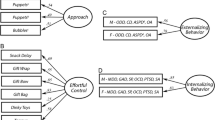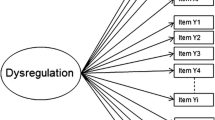Abstract
The validity of a multifactor conceptualization of locus of control (LOC) in severely disturbed adolescents was investigated. Ninety-two adolescents (44 female, 48 male) from a private psychiatric hospital completed the Children's Nowicki-Strickland Internal-External Locus of Control scale 3 months following admission. Five factors were found by both principal components and common factor analyses; the factors were named Peers, Parents, Achievement, Relationships, and Problems. Factors items had minimum loadings of 40, numbered 4 to 8 per factor, and accounted for 36.8% of the variance in principal components analysis and 28.5% of the variance in common factor analysis. Whereas traditional LOC was significantly related only to Global Assessment Scale (GAS) scores at admission and 3 months later, and to initial Diagnostic and Statistical Manual (3rd edition, revised) diagnosis of psychosis, individual factors were significantly related to IQ; GAS at admission, 3 months, and 15 months following admission; externalized aggression prior to admission; and diagnoses of psychosis, depression, and conduct disorder.
Similar content being viewed by others
References
Abramowitz, S. I. (1973). Internal-external control and social-political activism: A test of dimensionality of Rotter's internal-external scale.J. Consult. Clin. Psychol. 40: 196–201.
American Psychiatric Association. (1987).Diagnostic and Statistical Manual of Mental Disorders (3rd ed., rev.). Author, Washington, DC.
Battle, E. S., and Rotter, J. B. (1963). Children's feelings of personal control as related to social class and ethnic group.J. Person. 3: 482–490.
Cattell, R. B. (1966). The scree test for the number of factors.Multivar. Behav. Res. 1: 245–276.
Dahlquist, L. M., and Ottinger, D. R. (1983). Locus of control and peer status: A scale for children's perceptions of social interactions.J. Person. Assess. 47: 278–287.
Delga, I., Heinssen, R. K., Fritsch, R. C., Goodrich, W., and Yates, B. T. (1989). Psychosis, aggression, and self-destructive behavior in hospitalized adolescents.Am. J. Psychiat. 146: 521–525.
Dunn, L. M., and Markwardt, F. C., Jr., (1970).Manual for the Peabody Individual Achievement Test. American Guidance Service, Circle Pines, MN.
Endicott, J., Spitzer, R. L., Fleiss, J. L., and Cohen, J. (1976). The Global Assessment Scale: A procedure for measuring overall severity of psychiatric disturbance.Arch. Gen. Psychiat. 33: 766–771.
Ferrer, M., and Krantz, M. (1987). Self-control, locus of control and social status in children.Psychol. Rep. 60: 355–358.
Friedman, R., Goodrich, W., and Fullerton, C. (1985). Locus of control and severity of psychiatric illness in residential treatment of adolescents.Resid. Group Care Treat. 3: 3–13.
Gordon, D. A. (1977). Children's beliefs in internal-external control and self-esteem as related to academic achievement.J. Person. Assess. 41: 383–386.
Gossett, J. T., Lewis J. M., and Barnhart, F. D. (1983).To Find a Way: The Outcome of Hospital Treatment of Disturbed Adolescents. Brunner/Mazel, New York.
Kendall, P. C., Finch, A. J., Jr., Little, V. L., Chirico, B. M., and Ollendick, T. H. (1978). Variations in a construct: Quantitative and qualitative differences in children's locus of control.J. Consult. Clin. Psychol. 46: 590–592.
Kendall, P. C., Finch, A. J., Jr., and Mahoney, J. (1976). Factor specific differences in locus of control for emotionally disturbed and normal children.J. Person. Assess. 40: 42–45.
Hays, W. L. (1963).Statistics. Holt, Rinehart and Winston, New York.
Hollingshead, A. B., and Redlich, F. C. (1957).Social Class and Mental Illness. Wiley, New York.
Jastak, J. F., and Jastak, S. D. (1976).The Wide Range Achievement Test Manual. Guidance Associates of Delaware, Wilmington, DE.
Lefcourt, H. M. (1966). Internal versus external control of reinforcement: A review.Psychol. Bull. 65: 206–220.
Melges, F. T., and Weisz, A. E. (1971). The personal future and suicidal ideation.J. Nervious Mental Dis. 153: 244–250.
Metcalfe, R. J., and Dobson, C B. (1983). Factorial structure and dispositional correlates of ‘locus of control’ in children.Res. Educa. 30: 53–63.
Mirels, H. L. (1970). Dimensions of internal versus external control.J. Consult. Clin. Psychol. 34: 226–228.
Nowicki, S. (1976). Factor structure of locus of control in children.J. Genet. Psychol. 129: 13–17.
Nowicki, S. (1986).Children's Nowicki-Strickland Internal-External Locus of Control Unpublished manual, Emory University.
Nowicki, S., and Strickland, B. (1973). A locus of control scale for children.J. Consult. Clin. Psychol. 40: 148–154.
Piotrowski, C., and Dunharn, F. Y. (1983). Stability of factor structure in fifth graders on the Nowicki-Strickland Internal-External Control Scale.J. Psychol. 115: 13–16.
Raine, A., Rogers, D. B., and Venables, P. H. (1981). Factorial validity of the CNS-IE.J. Person. Social Psychol. 41: 758–765.
Rotter, J. B. (1966). Generalized expectancies for internal versus external control of reinforcement.Psychol. Monog. Volume 80 (Whole No. 609).
Rozeboom, W. (1982). The determinacy of common factors in large item domains.Psychometrika 47: 281–295.
Sanger, S. P., and Alker, H. A. (1972). Dimensions of internal-external locus of control and the women's liberation movement.J Social Issues 28: 115–129.
Snook, S. C., and Gorsuch, R. L. (1989). Component analysis versus common factor analysis: A Monte Carlo study.Psychol. Bull. 106: 148–154.
Strickland, B. R. (1989). Internal-external control expectancies: From contingency to creativity.Am. Psychol. 44: 1–12.
Thomas, G. (1973).A baseline evaluation of child caring institutions in Georgia. Regional Institute for Social Welfare Research, School of Social Work, University of Georgia.
Walters, L. H., and Klein, A. E. (1980). A cross-validated factor analysis of the Nowicki-Strickland Locus of Control Scale for children.Educat. Psychol. Measure. 40: 1059–1064.
Wechsler, D. (1955).Wechsler Adult Intelligence Scale. Psychological Corporation, New York.
Wechsler, D. (1974).Wechsler Intelligence Scale for Children—Revised. Psychological Corporation, New York.
Wechsler, D. (1981).Wechsler Adult Intelligence Scale—Revised. Psychological Corporation, San Antonio, TX.
Wilkinson, L. (1990).SYSTAT: The System for Statistics (version 5.0). SYSTAT Evanston, IL.
Wolf, T. M., Sklov. M. C., Hunter, S. M., and Berenson, G. S. (1982). Factor analytic study of the Children's Nowicki-Strickland Locus of Control scale.Educat. Psychol. Measure. 42: 333–337.
Author information
Authors and Affiliations
Additional information
Received doctorate in psychology from Stanford University. Current research interests include cost effectiveness and cost-benefit analysis of mental health services and substance abuse treatment programs, and cognitive determinants of premature cessation of therapy.
Received doctorate in clinical psychology from George Washington University. Her current interests include individual psychotherapy with children and adolescents and research on the effectiveness of home-based services.
Received doctorate in clinical psychology from George Washington University. His research interests include comorbidity of depression and conduct disorder, and outcome studies of adolescent disorders.
Received M.D. from Harvard Medical School and is the former Head of Child and Adolescent Psychiatry, University of Rochester, and former Chief, Child Research Branch, National Institute of Mental Health. Major interests are inpatient adolescent treatment, family therapy, and individual psychotherapy.
Rights and permissions
About this article
Cite this article
Yates, B.T., Hecht-Lewis, R., Fritsch, R.C. et al. Locus of control in severely disturbed adolescents: Loci for Peers, Parents, Achievement, Relationships, and Problems. J Youth Adolescence 23, 289–314 (1994). https://doi.org/10.1007/BF01536721
Received:
Accepted:
Issue Date:
DOI: https://doi.org/10.1007/BF01536721




